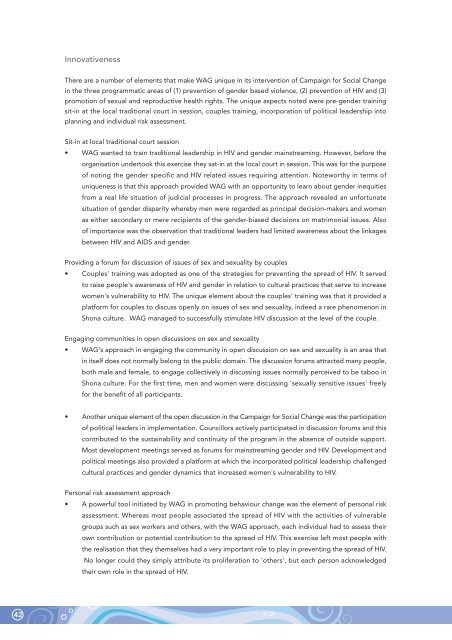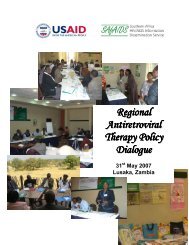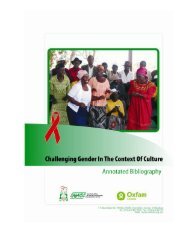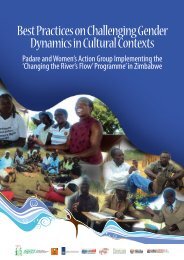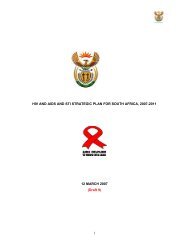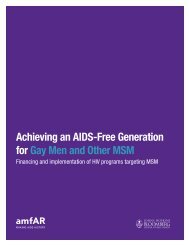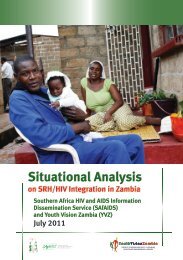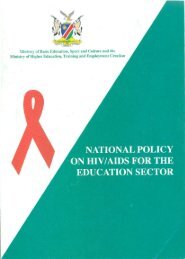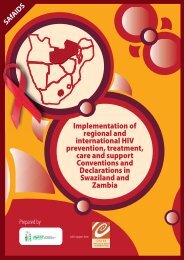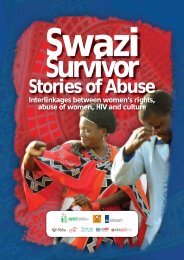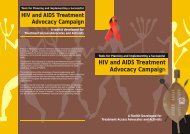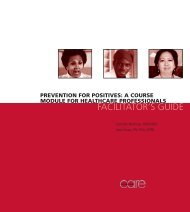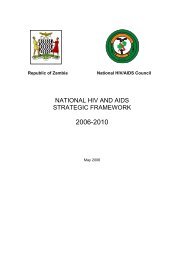Zimbabwean stories of "Best Practice" - SAfAIDS
Zimbabwean stories of "Best Practice" - SAfAIDS
Zimbabwean stories of "Best Practice" - SAfAIDS
Create successful ePaper yourself
Turn your PDF publications into a flip-book with our unique Google optimized e-Paper software.
InnovativenessThere are a number <strong>of</strong> elements that make WAG unique in its intervention <strong>of</strong> Campaign for Social Changein the three programmatic areas <strong>of</strong> (1) prevention <strong>of</strong> gender based violence, (2) prevention <strong>of</strong> HIV and (3)promotion <strong>of</strong> sexual and reproductive health rights. The unique aspects noted were pre-gender trainingsit-in at the local traditional court in session, couples training, incorporation <strong>of</strong> political leadership intoplanning and individual risk assessment.Sit-in at local traditional court session• WAG wanted to train traditional leadership in HIV and gender mainstreaming. However, before theorganisation undertook this exercise they sat-in at the local court in session. This was for the purpose<strong>of</strong> noting the gender specific and HIV related issues requiring attention. Noteworthy in terms <strong>of</strong>uniqueness is that this approach provided WAG with an opportunity to learn about gender inequitiesfrom a real life situation <strong>of</strong> judicial processes in progress. The approach revealed an unfortunatesituation <strong>of</strong> gender disparity whereby men were regarded as principal decision-makers and womenas either secondary or mere recipients <strong>of</strong> the gender-biased decisions on matrimonial issues. Also<strong>of</strong> importance was the observation that traditional leaders had limited awareness about the linkagesbetween HIV and AIDS and gender.Providing a forum for discussion <strong>of</strong> issues <strong>of</strong> sex and sexuality by couples• Couples' training was adopted as one <strong>of</strong> the strategies for preventing the spread <strong>of</strong> HIV. It servedto raise people's awareness <strong>of</strong> HIV and gender in relation to cultural practices that serve to increasewomen's vulnerability to HIV. The unique element about the couples' training was that it provided aplatform for couples to discuss openly on issues <strong>of</strong> sex and sexuality, indeed a rare phenomenon inShona culture. WAG managed to successfully stimulate HIV discussion at the level <strong>of</strong> the couple.Engaging communities in open discussions on sex and sexuality• WAG's approach in engaging the community in open discussion on sex and sexuality is an area thatin itself does not normally belong to the public domain. The discussion forums attracted many people,both male and female, to engage collectively in discussing issues normally perceived to be taboo inShona culture. For the first time, men and women were discussing 'sexually sensitive issues' freelyfor the benefit <strong>of</strong> all participants.• Another unique element <strong>of</strong> the open discussion in the Campaign for Social Change was the participation<strong>of</strong> political leaders in implementation. Councillors actively participated in discussion forums and thiscontributed to the sustainability and continuity <strong>of</strong> the program in the absence <strong>of</strong> outside support.Most development meetings served as forums for mainstreaming gender and HIV. Development andpolitical meetings also provided a platform at which the incorporated political leadership challengedcultural practices and gender dynamics that increased women's vulnerability to HIV.Personal risk assessment approach• A powerful tool initiated by WAG in promoting behaviour change was the element <strong>of</strong> personal riskassessment. Whereas most people associated the spread <strong>of</strong> HIV with the activities <strong>of</strong> vulnerablegroups such as sex workers and others, with the WAG approach, each individual had to assess theirown contribution or potential contribution to the spread <strong>of</strong> HIV. This exercise left most people withthe realisation that they themselves had a very important role to play in preventing the spread <strong>of</strong> HIV.No longer could they simply attribute its proliferation to 'others', but each person acknowledgedtheir own role in the spread <strong>of</strong> HIV.42


